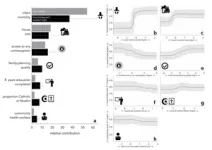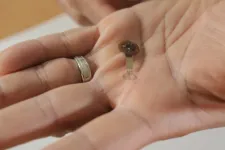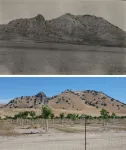(Press-News.org)
Keeping babies alive will lower population growth – new research
New research showing high infant mortality rates are contributing to an incessant rise of the global human population supports arguments for greater access to contraception and family planning in low- and middle-income nations.
In an article published in PLOS ONE, research led by Professor Corey Bradshaw, Matthew Flinders Professor of Global Ecology from Flinders University and Peter Le Souëf, Professor of Paediatrics from The University of Western Australia has found that with higher baby death rates and larger household sizes (as an indicator of population density), fertility rates are higher.
In the first study of its kind, Professor Bradshaw, says it provides a compelling argument that the United Nations Sustainable Development Goals for reducing infant mortality can be accelerated by increasing access to family planning.
“Although it sounds counterintuitive, higher baby death rates are linked to higher population growth because the more babies a women loses, the more children she is likely to have. Family planning, including access to quality contraception, enables women to plan pregnancies better and therefore reduce infant mortality to curb the so-called ‘replacement’, or ‘insurance’ effect,” Professor Bradshaw says.
“We evaluated six conditions thought to influence a woman’s fertility — availability of family planning, quality of family planning, education, religion, mortality, and socio-economic conditions, across 64 low- to middle-income countries.”
The research specifically tested whether
increasing the availability of family planning is associated with reduced fertility;
increasing the quality of family-planning services is associated with reduced fertility;
increasing years of female education is associated with reducing fertility;
increased fertility is observed in countries with a higher prevalence of adherents of Catholicism or Islam, two main religions that expressly dictate elements of fertility and/or family structure;
a larger mean household size is positively correlated with fertility, and lower socio-economic conditions; and
higher mortality (both infant and maternal) is associated with higher fertility.
Co-author Dr Melinda Judge from The University of Western Australia’s Medical School says, “Keeping babies alive actually reduced average fertility and helps put the brakes on population growth. Essentially, higher infant mortality and a larger household size increased fertility, whereas greater access to any form of contraception decreased fertility.”
“Interestingly, female education, home visits by health workers, quality of family planning services, and religious adherence all had weak, if any, contribution at the scale of entire countries.”
Professor Bradshaw says the United Nations Sustainable Development Goals 3 (good health and wellbeing) and 5 (gender equality) emphasise the basic right to exercise control over sexual and reproductive health through universal access to family planning.
The world is not on track to meet Goal 3 to reduce global maternal mortality to less than 70 per 100,000 live births and end preventable deaths of newborns and children under 5 years of age by 2030.
“Our results show the best pathway toward reaching these targets is by providing readily available and high-quality family-planning services. These actions will not only to decrease fertility rates, they will also to lower the number of unintended pregnancies, infant deaths, and maternal deaths.
“These findings support the notion that to encourage continued declines in global fertility, both infant survival rates plus access to contraception need to be increased”, explains Professor Bradshaw.
Co-author Chitra Saraswati also of The University of Western Australia’s Medical School says, “Recommendations for measures to decrease infant mortality emphasise improving the quality of antenatal care, increasing the number of trained healthcare staff at births, and improving postnatal care for both infants and mothers. Given the evidence that large households can worsen child health, improving living conditions to ameliorate high-density living could also indirectly result in lower fertility.”
“Allowing parents to choose family planning by providing readily available, modern methods of contraception can be expected to improve infant survival as well as reduce maternal mortality. This is because parents can plan and space their births, and being able to decide to have fewer children also has the potential to facilitate better investment in the overall health and well-being of families. It emphasises the importance of providing access to contraception as a direct contribution to decreasing infant mortality.”
“If we don’t act now to achieve the UN’s Sustainable Development Goals, fertility will rise, more children will die, and more women will succumb to birth-related deaths,” Professor Bradshaw concludes.
Lower infant mortality, lower household size, and more access to contraception reduce fertility in low- and middle-income nations. Bradshaw, CJA, C Perry, MA Judge, CM Saraswati, J Heyworth, PN Le Souëf. 2023. PLOS ONE. http://doi.org/10.1371/journal.pone.0280260
END
Wireless, battery-free bandage delivers electrical signals to help wounds heal
Bandage monitors healing, streaming data in real time to a smartphone or tablet
After healing is complete, bandage and electronics harmlessly absorb into the body
EVANSTON, Ill. — Northwestern University researchers have developed a first-of-its-kind small, flexible, stretchable bandage that accelerates healing by delivering electrotherapy directly to the wound site.
In an animal study, the new bandage healed ...
In his famous letter to the Royal Society dated Oct. 9, 1676, Antonie van Leeuwenhoek described a single-celled eukaryote (Vorticella) and its fascinating ultrafast cell contraction as the first set of discoveries. This kind of ultrafast cell contraction triggered by a Ca2+-dependent mechanism is distinct from the adenosine triphosphate (ATP)-dependent mechanisms found in actin-myosin and dynein/kinesin-tubulin systems.
Spirostomum, is a genus of millimeter-scale single-celled protists that are known for their incredibly rapid movement like Vorticella. They are capable ...
If the emergence of mechanically propelled weapons in prehistory is commonly perceived as one of the hallmarks of the advance of modern human populations into the European continent, the existence of archery has always been more difficult to trace. The recognition of these technologies in the European Upper Paleolithic has been hampered by ballistic overlaps between weapons projected with a thruster or a bow. Archery technologies are essentially based on the use of perishable materials; wood, fibers, leather, resins, and sinew, which are rarely preserved in European Paleolithic sites and make archaeological recognition ...
Berkeley — Climate change isn’t the only threat facing California’s birds. Over the course of the 20th century, urban sprawl and agricultural development have dramatically changed the landscape of the state, forcing many native species to adapt to new and unfamiliar habitats.
In a new study, biologists at the University of California, Berkeley, use current and historical bird surveys to reveal how land use change has amplified — and in some cases mitigated — the impacts of climate ...
Micro/nanorobots with self-propelling and -navigating capabilities have attracted extensive attention in drug delivery and therapy owing to their controllable locomotion in hard-to-reach body tissues.
However, developing self-adaptive micro/nanorobots that can adjust their driving mechanisms across multiple biological barriers to reach distant lesions is still a challenge.
Recently, a research team led by Prof. CAI Lintao from the Shenzhen Institute of Advanced Technology (SIAT) of the Chinese Academy ...
No two hearts beat alike. The size and shape of the the heart can vary from one person to the next. These differences can be particularly pronounced for people living with heart disease, as their hearts and major vessels work harder to overcome any compromised function.
MIT engineers are hoping to help doctors tailor treatments to patients’ specific heart form and function, with a custom robotic heart. The team has developed a procedure to 3D print a soft and flexible replica of a patient’s heart. They can then ...
The 25th International Conference on Redox Medicine, on June 21-23 in Paris, will revolutionize tomorrow’s medicine through redox. The translation of basic knowledge of redox into molecular medicine will be extensively discussed.
Prof. Guido Kroemer from the Université de Paris Cité, Hôpital Européen George Pompidou - AP-HP, is the key note speaker for this year. It is a great opportunity to share with Guido Kroemer his favorite topics and to have a unique moment of exchange with him.
Hallmarks of Aging & Redox Medicine: An Expanding Universe
Prof. Kroemer will highlight the “hallmarks of ageing: genomic instability, ...
West Virginia University physicists have made a breakthrough on an age-old limitation of the first law of thermodynamics.
Paul Cassak, professor and associate director of the Center for KINETIC Plasma Physics, and graduate research assistant Hasan Barbhuiya, both in the Department of Physics and Astronomy, are studying how energy gets converted in superheated plasmas in space. Their findings, funded by a grant from the National Science Foundation and published in the Physical Review Letters journal, will revamp ...
A daily dose of a strain of brewer’s yeast used to produce cachaça (distilled spirit made from fermented sugarcane juice) can act as a preventive against asthma, according to a Brazilian study involving male mice. The results are reported in an article published in the journal Probiotics and Antimicrobial Proteins. The authors are researchers at the University of São Paulo (USP) and the Federal University of Minas Gerais (UFMG). The yeast strain used in the study was Saccharomyces cerevisiae UFMG A-905.
Asthma is a common lung condition that causes breathing difficulties. It ...
(Santa Barbara, Calif.) — Blue foods — those that come from the ocean or freshwater environments — have tremendous potential to help address several global challenges. With careful implementation of policies that leverage these foods, nations could get a boost on efforts to reduce nutritional deficits, lower disease risk, decrease greenhouse gas emissions and ensure resilience in the face of climate change.
So say the team of experts at Blue Food Assessment, an international collaboration of scientists whose focus has been on the role of aquatic foods in global ...










